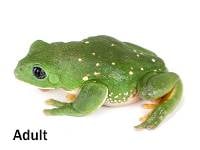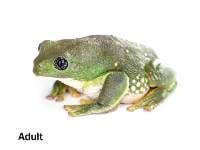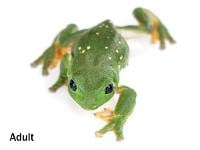Josh's Frogs
Mexican Leaf Frog Care
Looking for a pet frog that's a bit out of the ordinary? How about a frog that likes to bask like a lizard, looks like a Granny Smith apple, and actually does well with handling?
Then we have the frog for you!
Naming
Pachymedusa dacnicolor is commonly called the Mexican Leaf Frog in the hobby, although an alternate common name is the Mexican Giant Leaf Frog. It's big, green, and lives on leaves in Mexico, so someone knew what they were doing when they named it.
Housing
The minimum enclosure for this species is an 18x18x24 or similar sized tank. Height is very important to this species as they love to bask and vertical space is needed to create a temperature gradient. A mini halogen dome with a 25W white bulb, along with a tropical 5.0 or UVB100 bulb is ideal. Cycle the lights on a 12 hour ON - 12 hour OFF light cycle to satisfy this frogs lighting requirements.
Substrate for this frog can be as simple as Frog Foam or as complicated as a bioactive substrate layer using ABG mix. Each substrate methods have their perks and drawbacks. The frogs appreciate large vining structures, artificial or live, depending on your choice in substrate. These bulky amphibians require a hefty structure to climb on. don't rely only on live plants - fake bendy vines or vivarium wood are great options. A clean water bowl should always be available for the frogs to soak in.

Habitat
The Mexican Leaf Frog should have daytime temperatures approaching 80 F with a basking spot reaching up to 90 F. Remember, these are not your typical tropical tree frogs - they have to be able to bask! Failure to provide your Mexican Leaf Frog with it's required basking temperature can result in a very sick frog. A nighttime drop of up to 20 F is acceptable.
Along with those unusually warm temperatures, these fat frogs can handle fairly dry conditions but keeping them at about 50% humidity is a safe way to go most of the time. Mist in the morning, allowing the terrarium to dry out slightly, then mist again in the afternoon. Automatic misting systems help with repetitive misting, especially for those with busy schedules. As always, remember to keep an eye on temperature and humidity with a digital thermometer and hygrometer.
Feeding
Mexican Leaf Frogs are capable of eating crickets of varying sizes their whole lives. This can be supplemented with dubia roaches, hatched black soldier flies and blue bottle flies, and the occasional hornworm. At Josh’s Frogs, we feed our tree frogs primarily crickets.
Color
Pachymedusa dacnicolor are brilliant green on their backs with random white spots that are apparent in the later stages of tadpole development. Their underbellies are white with yellow flash marks in between their legs. This color scheme allows the frog to easily blend in to green foliage while at rest. The animals will take on a brownish purple hue at night.

Socialization
As with most frogs, Pachymedusa dacnicolor will be mostly solitary but can be kept in small groups with little aggression being displayed outside of the breeding season. As a general rule, these frogs do great in groups, but frogs can singled out during the breeding season. They are generally not outwardly aggressive to each other, but males' frequent mating attempts may bother females.
Size
Adult Mexican Leaf Frogs are large tree frogs. There is a slight size difference between males and females. An adult male may reach about 3.5” and females will be a bit larger and bulkier than a male, measuring up to 4”. Juvenile Leaf frogs will be about 1.25” long when they are sold at Josh’s Frogs.
Life Span
There's not any reliable data surrounding the average lifespan of Pachymedusa dacnicolor, but based on similar species we'd expect them to easily live 10+ years in captivity with proper care.
Sex
Sexing adult Pachymedusa dacnicolor can be a little tricky outside of mating season as both males and females will vocalize if gently squeezed using your thumb and forefinger on their sides. During mating season, males will develop dark nuptial pads on the inside of their ""thumbs"". Males are smaller and will typically call when kept in a rain chamber set up.
Breeding
Pachymedusa dacnicolor will breed in early summer after a warming period and being introduced to a rain chamber. The rain intervals need to be set with longer bouts occurring at night and small “showers” occurring during the day. Amplexus will happen sporadically but may not always result in a breeding event. When a female lays eggs she will affix them to either the walls of the rain chamber or on broad leafed plants within the rain chamber.
Tadpole Care
Eggs will be green and there can be several hundred produced during one breeding event. Eggs need to be kept moist or they will dry out and not form tadpoles. Tadpoles develop over the course of 2 weeks and drop into water provided below. Formation into froglets can take from 3-5 months to completely develop, depending on water temperature. Tadpoles can be fed a varied diet of Josh’s Frogs Tree Frog Tadpole Food, Repashy Shrimp Souffle*, and frozen bloodworms. These tadpoles can be very carnivorous and should be fed a ton. Of course, very frequent water changes will have to accompany heavy feedings in order to maintain good water quality.
*Since this product has been discontinued, we alternate between Repashy Soilent Green and Repashy Meat Pie Reptile.

Natural Range
This species occurs from southern Sonora, southward along the Pacific coast (including the Balsas Depression), to southern Oaxaca, Mexico. This frog is found up to 1,000m asl and live in dry tropical forests, generally close to water.
Conclusion:
The Mexican leaf frog is an interesting species that isn't very common in the hobby. However, they have a number of features that make them a good intermediate-level pet if given proper care.



